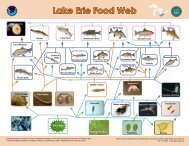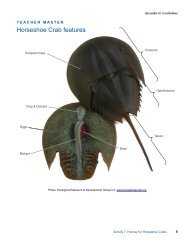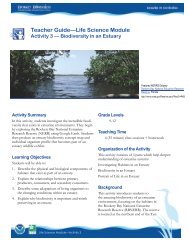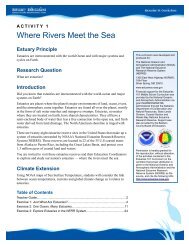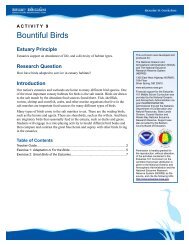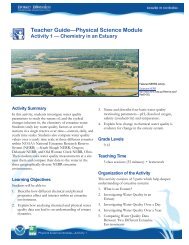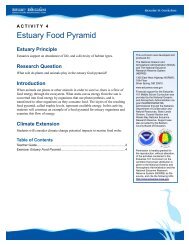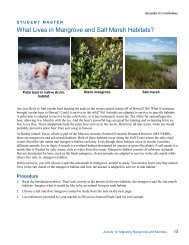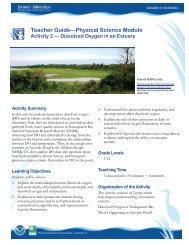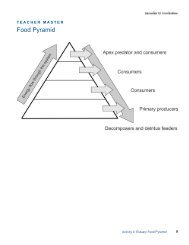The Great Oyster Mystery Teacher Guide - Estuaries NOAA
The Great Oyster Mystery Teacher Guide - Estuaries NOAA
The Great Oyster Mystery Teacher Guide - Estuaries NOAA
You also want an ePaper? Increase the reach of your titles
YUMPU automatically turns print PDFs into web optimized ePapers that Google loves.
<strong>The</strong> <strong>Oyster</strong>’s Enemies<strong>Oyster</strong>s are able to tolerate lower salinity levels than many of their predators (oyster drills and stone crabs) andparasites (Perkinsus marinus that causes dermo disease). This is important because oysters cannot run away from theirenemies and they have no way to defend themselves, except their protective shells, which oyster drills, stone crabs,and Perkinsus marinus can easily get into. <strong>The</strong> oyster’s tolerance for lower salinity levels means that freshwaterinflow into oyster beds can help oysters thrive because it tends to lower the numbers of oyster predators and parasites.<strong>Oyster</strong>s can survive within a wide range of salinity, from 5 ppt. to 40 ppt, but they do best within the range of 14 ppt.to 28 ppt. <strong>Oyster</strong> drills and stone crabs cannot tolerate salinities less than 15 ppt. for long periods of time andPerkinsus marinus does not tolerate salinities below 8 ppt. <strong>The</strong> table below shows the lower limits of salinitytolerances for oysters, oyster drills, stone crabs, and Perkinsus marinus.Organism<strong>Oyster</strong><strong>Oyster</strong> DrillStone CrabPerkinsus marinus(cause of dermo disease)Lower Limit of Salinity Tolerance5 ppt.15 ppt.15 ppt.8 ppt.Procedure1. Compare the salinity graphs for Copano Bay and Aransas Bay (from Exercise 2) with the young oyster abundancegraphs (from Exercise 1). During what time period were oysters within their preferred tolerance range for salinityin each bay? Is there a relationship between when oysters were in their preferred salinity conditions and whenyoung oysters were abundant?2. Compare the precipitation graph for Copano Bay with the salinity graph for Copano Bay. Also, examine the streamdischarge data for the Aransas River. Are there any clues in the precipitation graph and discharge data that suggestwhy salinity in Copano Bay and Aransas Bay fell so dramatically in July 2007?3. Look at the graph below that shows number of “market-sized” oysters infected with Perkinsus marinus in CopanoBay during 2007 and 2008. Is there a relationship with the salinity graph? Is there a correlation with the youngoyster abundance graph?Activity 11: <strong>The</strong> <strong>Great</strong> <strong>Oyster</strong> <strong>Mystery</strong> 19



